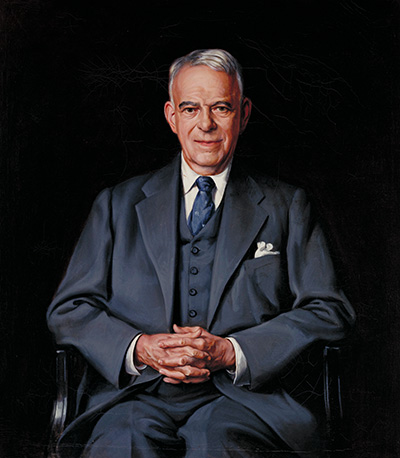Samuel James Crowe

Samuel James Crowe
- Artist:
- Jacques Maroger
- Date:
- 1954
- Medium:
- Oil on canvas
- Dimensions:
- 33 x 29.5 in.
Samuel James Crowe
1883-1955
Crowe, Johns Hopkins’ first otolaryngology director, was born in Washington County, Virginia. He received his A.B. from the University of Georgia in 1904. Upon the urging of his father to pursue a career in medicine, Crowe entered the Johns Hopkins University School of Medicine, earning his M.D. in 1908.
Upon graduation, Crowe was appointed assistant in surgery and assigned to work with Harvey W. Cushing on the pituitary gland in the Hunterian Laboratory. In 1909, he was appointed assistant resident surgeon and was in charge of the neurosurgical cases under Cushing’s supervision, serving in that capacity for a year. He worked with Cushing for four years as an assistant and resident and, when Cushing moved to Harvard University, Crowe planned to accompany him. Instead, William S. Halsted persuaded Crowe to accept directorship of the new division of otolaryngology at Johns Hopkins.
To prepare for the new post, Crowe spent time training in Germany. He is credited with establishing the first modern clinic of otolaryngology in the United States. He was also the first to recognize that lymphoid tissue blockage of the eustachian tube was responsible for hearing loss in children and that such a loss could be prevented or reversed by the removal of the excess tissue through surgery or radon therapy. Crowe foresaw the role that the audiometer would play in the medical field and used the instrument in studies correlating functional performance of the ear with the histological sections of the middle and inner ear.
Crowe’s department was considered the most productive of its kind in the country, and was built almost entirely upon outside grants, many of which were obtained by gifts from Crowe’s private patients.
After retiring in 1952, Crowe set about writing a history of the Department of Surgery at the request of Alfred Blalock. The manuscript was completed in early November 1955. Just a few hours later, Crowe suffered a massive coronary occlusion, from which he died two weeks later.
"*" indicates required fields
